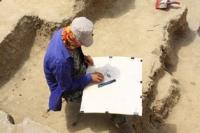You are here
Kultobe Yasy in Turkestan.


The city of Turkestan - ancient capital of Kazakhstan.
“People usually feel funny, smile and laugh when I tell them
about my strong belief in the very existence of prehistoric
advanced technology and great civilizations of wilier races.
I just can't wait to see their faces at time the truth is revealed”
Toba Beta.
The best photos of Turkestan.
Hill Kultobe is located in 400 meters from Haji Akhmed Yasavis Mausoleum. Kultobe is a late name of the hill which arose on the place of the settlement about the XXth centuries back. In the XIX - XX century of century the local population took household garbage and ashes from furnaces here.
From here, actually, and name: Kultobe - the Cindery hill. Scientists assume that by the time of construction of the mausoleum at the end of the 14th century the ancient settlement Kultobe was already abandoned and managed to turn into the hill.
Life on the settlement stood two centuries earlier. Though it is possible, certain houses stood later. Archeologists, found traces of presence of life of that era on the hill. In the XIX century on Kultobe there lived people again.
The military unit was deployed in the XX century here. Opening of building of an ancient citadel of the city of Yasa - the predecessor of Turkestan became a result of work of the Turkestan archaeological expedition, within 3 years.
This fortification with the powerful plastered walls, which thickness to 2,5 m. Laborious work of archeologists allowed to open rooms, corridors, arch passes, domes, loopholes. The remains of loopholes demonstrate that it was the fortification which had defensive value.
On the ancient settlement the temple was located. The central and most mysterious element of planning is the construction of a crosswise form. This complex of well remained constructions, represents the temple of one of the religions, widespread, in the first centuries, a new era across all Central Asia.
"Similar "cross-shaped plannings" are known in monumental architecture of cult constructions of Central Asia. Chronologically time of their functioning belongs to the III-VIII centuries. They were partially dug out near Taraz, are known in ancient layers of Tashkent.
The construction, similar in a form, is investigated near Bukhara". The ends of the parties of "cross" has the form of four petals. External surfaces of walls are built with a small bias. The sizes of "cross" - 18 x 18 meters.
From the South and the East other rooms adjoin to it. They mainly long and vaulted, performed various office functions. Exactly there could be a powerful religious center, the community practising religion of Christian or Buddhist sense.
Hajj Ahmed Yasavi came here to preach that the word and a vital example to convince locals to address in Islamic belief. It is possible to find confirmation or to disprove such interpretation of this historical story, only studying ancient sources and conducting excavation.
The most ancient part of a citadel is the crosswise building in the plan with vaulted rooms in the first floor, having fine safety. To crosswise fortress the long vaulted rooms surrounding a small internal court yard in which there was certain, probably, folding, frame construction were attached subsequently.
Construction of a powerful fortification with angular towers went the third stage. It surrounded the huge site of the territory. Approximately so there was a fortification of a citadel - the main kernel of the city. Directly city was farther.
In the plan construction represents difficult system of the various rooms occupying a significant area in the southern part of the hill Kultobe. Arches are well looked through, ranks of a pakhsa, a ramp perfectly remained, there passed the ladder on the second floor which till our time did not remain.
Among artifacts which archeologists already found on Kultobe, a ceramics collection, gold plaques with which attendants of ancient cults decorated the clothes. On a floor of one of rooms archeologists found, so-called, "alabaster idols" probably local deities - patrons of the house, a home, family unit.
Authority:
The head of an expedition, the chief researcher of institute of Archeology of A. Margulana Erbulat Akizhanovich Smagulov. Interview to the Caravan newspaper 10.04.2013. It is printed with the permission of Erbulat Smagulov.
Photos
Alexander Petrov.







